Tour of the church
The Sanctuary of our church was re-ordered in the first half of 2006, and the new altar dedicated on 8th September 2006 by The Most Rev. Kevin McDonald, Archbishop of Southwark.
All this was made possible through the tremendous generosity of the people of the parish. The architect was Javier Castanon and his associates, and the artist Theodore Gillick. The builders were Collinstown.
THE SANCTUARY
The Sanctuary
 In the Introduction to the Roman Missal we read, “The church constantly seeks the noble assistance of the arts and admits the artistic expressions of all peoples and regions… she strives to promote new works of art that are in harmony with the character of each successive age.” Theodore Gillick, a young sculpture, was recommended to us by Javier, the architect, as someone who could produce art that nourishes faith and devotion. Theodore is an identical twin, born in 1972 and comes from a very artistic family. He has been responsible for the sculptures throughout the sanctuary. Theodore went to Portugal to find the stone, which is Mocha, and in discussion with Father Anthony, our Parish Priest, and the working party, created what you see today.
In the Introduction to the Roman Missal we read, “The church constantly seeks the noble assistance of the arts and admits the artistic expressions of all peoples and regions… she strives to promote new works of art that are in harmony with the character of each successive age.” Theodore Gillick, a young sculpture, was recommended to us by Javier, the architect, as someone who could produce art that nourishes faith and devotion. Theodore is an identical twin, born in 1972 and comes from a very artistic family. He has been responsible for the sculptures throughout the sanctuary. Theodore went to Portugal to find the stone, which is Mocha, and in discussion with Father Anthony, our Parish Priest, and the working party, created what you see today.
The Altar
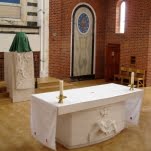 This is a most important symbol in the church. Many altars today bear a representation of the last supper. This emphasises the Altar as the table of the Lord on which the people of God are called together to give thanks to God and receive the body and blood of Christ. We have tryied to represent on the altar the life and death of Jesus, because the altar is also the place where the sacrifice of the cross is perpetuated in the mystery. Theodore said, “Here I wanted to produce an image that was doctrinal, that echoed in some way the function of the altar and the mystery that is enacted on it, and that complemented the modernist design of the sanctuary with a modern iconography.” What followed, issued from a text in the catechism: Article 648 ‘Thus the Body of Christ is raised by the hands of the Father into the new life of the Spirit.’ The image also reflects the hands of the priest during the Consecration and is intended to make the link between Christ’s death and resurrection, the Eucharistic Sacrifice and the spiritual rebirth that results from partaking in it.
This is a most important symbol in the church. Many altars today bear a representation of the last supper. This emphasises the Altar as the table of the Lord on which the people of God are called together to give thanks to God and receive the body and blood of Christ. We have tryied to represent on the altar the life and death of Jesus, because the altar is also the place where the sacrifice of the cross is perpetuated in the mystery. Theodore said, “Here I wanted to produce an image that was doctrinal, that echoed in some way the function of the altar and the mystery that is enacted on it, and that complemented the modernist design of the sanctuary with a modern iconography.” What followed, issued from a text in the catechism: Article 648 ‘Thus the Body of Christ is raised by the hands of the Father into the new life of the Spirit.’ The image also reflects the hands of the priest during the Consecration and is intended to make the link between Christ’s death and resurrection, the Eucharistic Sacrifice and the spiritual rebirth that results from partaking in it.
The Ambo
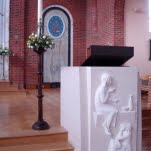 The Introduction to the Roman Missal says: “The dignity of the Word of God requires that the Church have a place that is suitable for the proclamation of the word and towards which the attention of the whole congregation naturally turns during the Liturgy of the Word.” Fr Anthony asked that the carving on Javier’s design depict the incident in Luke 10: 30-42 where Mary is at the feet of Jesus, as a true disciple, listening. Theodore says of his carving, “A simple translation of the story fitted into a restricted space. At the end of the meal, Christ perches himself on the table and is seen here involved in explaining the scripture while Mary sits at His feet contemplating his words and rightly putting clearing and washing up as far down the list of priorities as possible.”
The Introduction to the Roman Missal says: “The dignity of the Word of God requires that the Church have a place that is suitable for the proclamation of the word and towards which the attention of the whole congregation naturally turns during the Liturgy of the Word.” Fr Anthony asked that the carving on Javier’s design depict the incident in Luke 10: 30-42 where Mary is at the feet of Jesus, as a true disciple, listening. Theodore says of his carving, “A simple translation of the story fitted into a restricted space. At the end of the meal, Christ perches himself on the table and is seen here involved in explaining the scripture while Mary sits at His feet contemplating his words and rightly putting clearing and washing up as far down the list of priorities as possible.”
The Tabernacle Pedestal
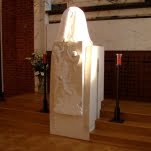 Here is a representation of the Heavenly Host. Theodore writes: “I based this on the understanding that at Mass we temporarily participate in, and merge with, the continual praise of Christ offered by the entire communion of Angels and Saints for his continuing and perpetual redeeming sacrifice being made to the Father on our behalf. This panel also recalls the Ark of the Covenant whose praying angels guarded its corners, as here they ride up to the Ark of the New Covenant.”
Here is a representation of the Heavenly Host. Theodore writes: “I based this on the understanding that at Mass we temporarily participate in, and merge with, the continual praise of Christ offered by the entire communion of Angels and Saints for his continuing and perpetual redeeming sacrifice being made to the Father on our behalf. This panel also recalls the Ark of the Covenant whose praying angels guarded its corners, as here they ride up to the Ark of the New Covenant.”
The Font
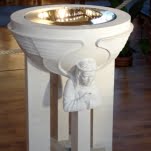 In ancient times, this was referred to as the womb of the Church. It is an important symbol that in recent years has moved from the entrance of the Church to a place near the sanctuary but not on the sanctuary, where people can see the moment of baptism. This makes it easier to celebrate Baptism during Mass.
In ancient times, this was referred to as the womb of the Church. It is an important symbol that in recent years has moved from the entrance of the Church to a place near the sanctuary but not on the sanctuary, where people can see the moment of baptism. This makes it easier to celebrate Baptism during Mass.
The Crucifix
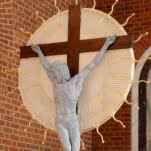 The church requires that there be a cross, with the figure of Christ crucified upon it, either on the altar or near it, where it is clearly visible to the assembled congregation. Theodore writes, “I feel a Crucifix should aim to lead the viewer into contemplating, understanding and knowing Jesus and their faith. The Gospel accounts of the Crucifixion are painful and heart breaking to read, so in this Crucifix the Corpus is portrayed with honesty. It is intended to be beautiful, not brutal, but I have not attempted to hide the suffering or the burden of sin being carried by his Body. By the same token, the Cross is a powerful symbol of redemption and gives us the great paradox within the image of a crucifix of great suffering and great redemptive glory. The painful reminder of the consequences of sin is the Corpus which is given a beautiful and radiant backdrop in the symbol of hope, forgiveness and resurrection. The white disc of wood behind the Corpus is both halo and Eucharist.”
The church requires that there be a cross, with the figure of Christ crucified upon it, either on the altar or near it, where it is clearly visible to the assembled congregation. Theodore writes, “I feel a Crucifix should aim to lead the viewer into contemplating, understanding and knowing Jesus and their faith. The Gospel accounts of the Crucifixion are painful and heart breaking to read, so in this Crucifix the Corpus is portrayed with honesty. It is intended to be beautiful, not brutal, but I have not attempted to hide the suffering or the burden of sin being carried by his Body. By the same token, the Cross is a powerful symbol of redemption and gives us the great paradox within the image of a crucifix of great suffering and great redemptive glory. The painful reminder of the consequences of sin is the Corpus which is given a beautiful and radiant backdrop in the symbol of hope, forgiveness and resurrection. The white disc of wood behind the Corpus is both halo and Eucharist.”
Stature of Our Lady
 Our church is dedicated to Our Lady Immaculate, and the statue standing high over the sanctuary reminds us of that. It is a replica (although some what larger) of the one in the Chapel of Our Lady of the Miraculous Medal in the Rue de Bac, Paris, which was sculptured by Real del Sarte in Carrare marble. In this statue, Mary is holding a globe, which represents the world, of which she is Queen. Our statue is made of white marble against a background of night-blue mosaic specked with gold and framed in Italian marble. On the walls to either side of the altar are medallions depicting the Miraculous Medal, the insignia of the Legion of Mary.
Our church is dedicated to Our Lady Immaculate, and the statue standing high over the sanctuary reminds us of that. It is a replica (although some what larger) of the one in the Chapel of Our Lady of the Miraculous Medal in the Rue de Bac, Paris, which was sculptured by Real del Sarte in Carrare marble. In this statue, Mary is holding a globe, which represents the world, of which she is Queen. Our statue is made of white marble against a background of night-blue mosaic specked with gold and framed in Italian marble. On the walls to either side of the altar are medallions depicting the Miraculous Medal, the insignia of the Legion of Mary.
THE LADY CHAPEL
The Lady Chapel
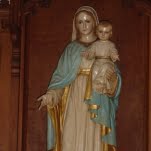 The Lady Chapel is a special area of the church building dedicated to the Blessed Mother of Jesus. The panelling and altar have been taken from the small chapel originally erected on the site, now used as a parish hall (to the right of the church). There is a hand carved wooden statue of Our Lady of the Rosary and Child, both holding a painted 15 decade rosary. The statue is 36 inches high and has been carved in Canadian Pine (although painted at a later time by a parishioner). The carving took place from 8th April to 9th May 1957 by Mr P J Dapré, and carved on the back corner is his name, and Bow 1957.
The Lady Chapel is a special area of the church building dedicated to the Blessed Mother of Jesus. The panelling and altar have been taken from the small chapel originally erected on the site, now used as a parish hall (to the right of the church). There is a hand carved wooden statue of Our Lady of the Rosary and Child, both holding a painted 15 decade rosary. The statue is 36 inches high and has been carved in Canadian Pine (although painted at a later time by a parishioner). The carving took place from 8th April to 9th May 1957 by Mr P J Dapré, and carved on the back corner is his name, and Bow 1957.
As Mother of God and the wife of St Joseph, Mary was exalted by divine grace above all angels and men and women. Mary was born in Jerusalem, but living in Nazareth, she was visited by the archangel Gabriel who announced to her that she would become the mother of Jesus by the power of the Holy Spirit. She became betrothed to Joseph and, due to the census ordered by Emperor Augustus, they travelled to Bethlehem where she gave birth to Jesus. Nothing much is known of Mary’s life over the next few years apart from a few mentions here and there, such as searching for the young Jesus in the temple in Jerusalem when he was with the learned elders, and the wedding feast at Cana where she witnessed His first miracle. She is of course present at the crucifixion when she is placed into John’s care, and she was with the disciples in the days leading up to Pentecost.
The belief that Mary’s body was assumed into heaven is one of the oldest traditions of the Catholic Church, and one which Pope Pius XII declared in his dogma in 1950. The Feast of the Assumption is celebrated on 15th August. The dogma of the Immaculate Conception that Mary, as the Mother of the Second Person of the Holy Trinity, was free of original sin at the point of her conception was proclaimed by pope Pius IX in 1854, and the Feast is celebrated on 8th December. The birthday of Our Lady has been celebrated on 8th September since the seventh century.
Mary is often referred to as Our Mother. Whist she is not our Mother in the physical sense, she is called a spiritual mother, for she conceives, gives birth, and nurtures the spiritual lives of grace for each person. She is ever present at the side of each person, giving nourishment and hope, from the moment of spiritual birth at Baptism to the moment of death.
St Anthony of Padua
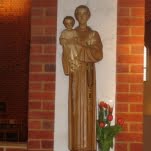 This statue stands on the right hand wall of the Lady Chapel. Born in 1195 in Lisbon, Portugal, he died on 13th June 1231of natural causes. He was canonised on 30th May 1232 by Pope Gregory IX at Spoleto, Italy.
This statue stands on the right hand wall of the Lady Chapel. Born in 1195 in Lisbon, Portugal, he died on 13th June 1231of natural causes. He was canonised on 30th May 1232 by Pope Gregory IX at Spoleto, Italy.
Anthony’s wealthy family wanted him to be a great nobleman, but for the sake of Christ he became a poor Franciscan. When the remains of the first Franciscan martyrs were brought to be buried in his church, Anthony was moved to leave his order, enter the Friars Minor, and go to Morocco to evangelise. Shipwrecked at Sicily, he joined some other brothers who were going to the church in Portiuncula. One day when a scheduled speaker failed to appear, the brothers pressed him into speaking. He impressed them so much that he was thereafter constantly travelling, evangelising, preaching, and teaching theology through Italy and France.
A gifted speaker, he attracted crowds everywhere he went, speaking in multiple tongues; legend says that even the fish loved to listen. Proclaimed a Doctor of the Church on 16th January 1946.
THE NAVE
Statue of St Joseph
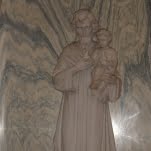 Everything we know about the husband of Mary and the foster father of Jesus comes from Scripture and that has seemed too little for those who made up legends about him.
Everything we know about the husband of Mary and the foster father of Jesus comes from Scripture and that has seemed too little for those who made up legends about him.
We know he was a carpenter, a working man, for the sceptical Nazarenes ask about Jesus, “Is this not the carpenter’s son?” (Matthew 13:55). He wasn’t rich for when he took Jesus to the Temple to be circumcised and Mary to be purified he offered the sacrifice of two turtledoves or a pair of pigeons, allowed only for those who could not afford a lamb (Luke 2:24).
Despite his humble work and means, Joseph came from a royal lineage, from David, the greatest King of Israel (Matthew 1:1-16 and Luke 3:23-38). We know Joseph was a compassionate, caring man. When he discovered Mary was pregnant after they had been betrothed, he knew the child was not his but was as yet unaware that she was carrying the Son of God. He planned to divorce Mary according to the law but he was concerned for her suffering and safety. He knew that women accused of adultery could be stoned to death, so he decided to divorce her quietly and not expose her to shame or cruelty (Matthew 1:19-25).
We know Joseph was man of faith and obedient to whatever God asked of him. When the angel came to Joseph in a dream and told him the truth about the child Mary was carrying, Joseph immediately took Mary as his wife. When the angel came again to tell him that his family was in danger, he immediately left everything he owned, all his family and friends, and fled to a strange country with his young wife and the baby. He waited in Egypt without question until the angel told him it was safe to go back (Matthew 2:13-23).
We know Joseph loved Jesus. His one concern was for the safety of this child entrusted to him. Not only did he leave his home to protect Jesus, but upon his return settled in the obscure town of Nazareth out of fear for his life. When Jesus stayed in the Temple we are told Joseph (along with Mary) searched with great anxiety for three days for him (Luke 2:48).
Since Joseph does not appear in Jesus’ public life, at his death, or resurrection, many historians believe Joseph probably had died before Jesus entered public ministry. Joseph is the patron of the dying because, assuming he died before Jesus’ public life, he died with Jesus and Mary close to him, the way we all would like to leave this earth. Joseph is also patron of the Universal Church, fathers, carpenters, and social justice.
We celebrate two feast days for Joseph: March 19 for Joseph the Husband of Mary and May 1 for Joseph the Worker.
Statue of the Sacred Heart
 The Sacred Heart Statue is one of the most famous religious devotions to Jesus’ physical heart as the representation of His divine love for Humanity.
The Sacred Heart Statue is one of the most famous religious devotions to Jesus’ physical heart as the representation of His divine love for Humanity.
It stresses the central Christian concept of loving and adoring Jesus. The origin of this devotion in its modern form is derived from a French Roman Catholic nun, Marguerite Marie Alacoque (1647-1690), who said she learned the devotion from Jesus in visions. The Sacred Heart is often depicted in Christian art as a flaming heart shining with divine light, pierced by the lance-wound, surrounded by a crown of thorns, surmounted by a cross and bleeding. Sometimes the image is over Jesus’ body with his wounded hands pointing at the heart. The wounds and crown of thorns allude to the manner of Jesus’ death, while the fire represents the transformative power of love. The Feast of the Sacred Heart has been a Solemnity in the Roman Catholic liturgical calendar since 1856, and is celebrated 19 days after Pentecost. As Pentecost is always celebrated on a Sunday, the Feast of the Sacred Heart always falls on a Friday.
Stations of the Cross
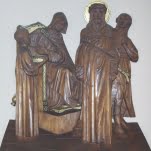 The Stations of the Cross (which are sometimes referred to as the Way of the Cross) refers to the depiction of the final hours (or passion) of Jesus, and the devotion of commemorating the Passion. Although this commemoration can be observed or prayed at any time of the year, it is more commonly done during the season of Lent, and especially on Good Friday.
The Stations of the Cross (which are sometimes referred to as the Way of the Cross) refers to the depiction of the final hours (or passion) of Jesus, and the devotion of commemorating the Passion. Although this commemoration can be observed or prayed at any time of the year, it is more commonly done during the season of Lent, and especially on Good Friday.
The 14 stations in our church are carved in wood in Canadian Pine, although decorated at a later date. The figures are 16 inches high and the stations were carved between 8th November 1957 and 4th February 1958 by twin brothers Pius and Leo Dapré. Pius carved station numbers 5,6,7,10,11,12 & 14, and Leo the rest. On the right hand bottom corner of station 14 is the inscription PJ & LF Dapré, Bow 1958.
Memorial Chapel
 The Memorial Chapel was completed in December 2010 after converting a redundant confessional. The Chapel & Icon were blessed during the Confirmation Mass on 18th June 2011 by The Right Reverend Paul Hendricks, Titular Bishop of Rosemarkie and Auxiliary in the Archdiocese of Southwark.
The Memorial Chapel was completed in December 2010 after converting a redundant confessional. The Chapel & Icon were blessed during the Confirmation Mass on 18th June 2011 by The Right Reverend Paul Hendricks, Titular Bishop of Rosemarkie and Auxiliary in the Archdiocese of Southwark.
The icon in the Memorial Chapel was completed by Ian Knowles who lives and works for most of the year in the Holy Land, completing commissions in various buildings from new icons from scratch, to refurbishment work. He also travels the world undertaking commissions and giving courses in the art of iconography. For a complete description of our icon, please click here for The icon of Christ in glory